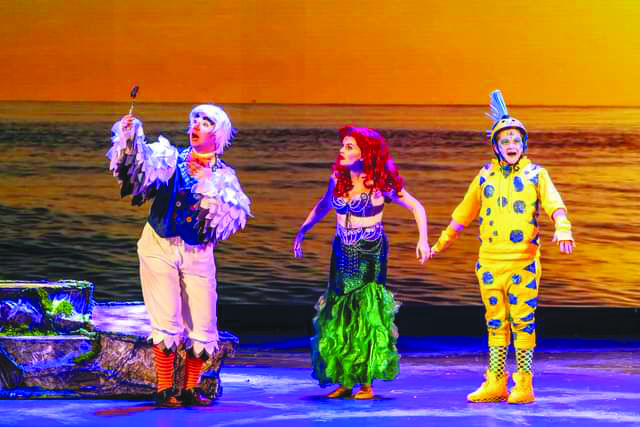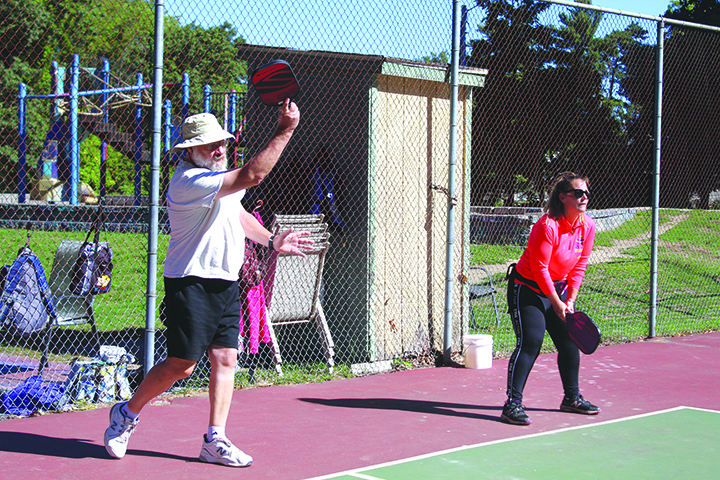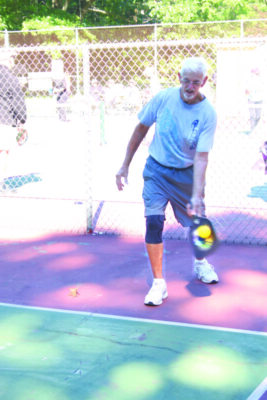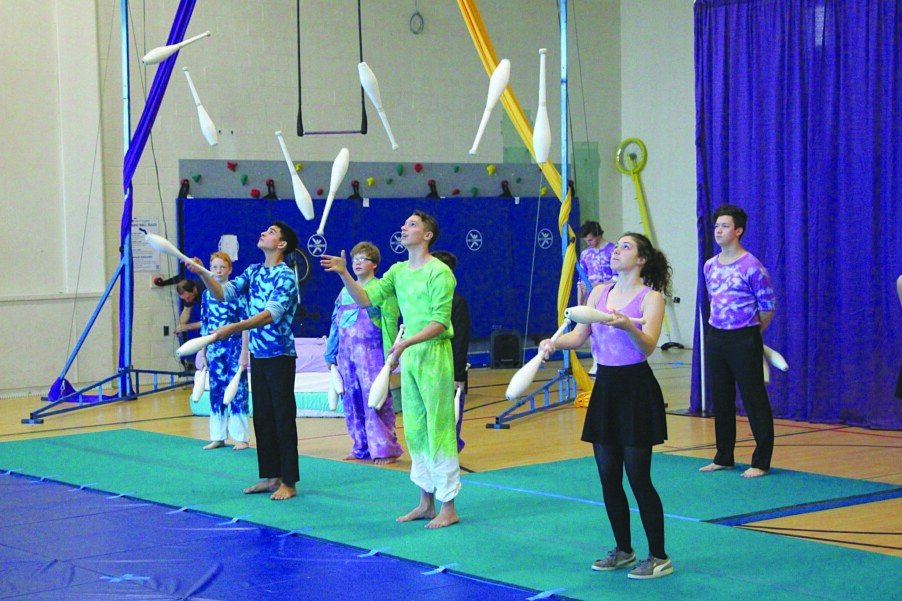The latest from NH’s theater, arts and literary communities
• Concord celebrates the arts: The Capital Arts Fest, a free event hosted by the League of New Hampshire Craftsmen, will take place on Saturday, Sept. 24, and Sunday, Sept. 25, outside on south Main Street between Fayette and Concord streets in downtown Concord. The line-up for this two-day event includes a juried fine craft fair (running from 10 a.m. to 5 p.m. on Saturday and 10 a.m. to 4 p.m. on Sunday), a KidsCreate! Activity tent, a historic walking tour at 10:30 a.m. on Saturday, an opening reception for the NH Potters Guild show “Storied in Clay” at 4 p.m. on Saturday, performances on the street (including Sindy Chown of Barranquilla Flavor Multicultural Program, the Concord Coachmen Chorus and the NH Scot Pipe Band and Scottish Highland Dance) and performances on the Capitol Center for the Arts Fest stage, according to the schedule at nhcrafts.org. The music lineup on Saturday includes Symphony NH Jazz Quartet at 12:30 p.m., Andrew North and the Rangers at 3 p.m. and Firefall at 5 p.m. On Sunday, the lineup includes Concord Community Music School Jazz Ensemble at 12:30 p.m., the school’s Folk Ensemble at 1:15 p.m. and Screaming Orphans Celtic Performance at 2:30 p.m., the schedule said. The Fest will also feature food from Chubba Wubba, Holy Moly, Col’s Kitchen and Batulo’s Kitchen, the website said.
• Mr. Wolf on stage: Theatre Kapow presents Mr. Wolf at the Bank of NH Stage (16 S. Main St., Concord), with showtimes on Friday, Sept. 23, and Saturday, Sept. 24, at 7:30 p.m., and Sunday, Sept. 25, at 4 p.m. The show follows a 15-year-old girl who has just been returned to her family after having been abducted as a toddler, according to tkapow.com. “Pulitzer finalist Rajiv Joseph unfurls Theresa’s new life, as she and her family struggle to make sense of a shattered past and an uncertain future in the wake of a parent’s worst nightmare,” the description said. This production contains some adult themes and may not be suitable for all viewers, according to the website (which offers more details about some of the content). Purchase tickets, which cost $28 for adults and $23 for students, at ccanh.com.
Music at the museum
The Currier Museum of Art (150 Ash St., Manchester, 669-6144) hosts local rock band Regals on Thursday, Sept. 22, as a part of its ongoing program Art After Work: Free Thursday Nights. The event, running weekly from 5 to 8 p.m., features free gallery admission and exhibition tours, live music, and a full menu available for purchase at the Winter Garden. Future musical guests include Kemp Harris and Adam O on Sept. 29, and Jessye DeSilva on Oct. 6. For more information, visit currier.org.
• Meet Miss Holmes:The Milford Area Players will perform Miss Holmes, a play by Christopher M. Walsh based on the works of Sir Arthur Conan Doyle, Friday, Sept. 23, through Sunday, Oct. 2, at the Amato Center for the Performing Arts (56 Mount Vernon St., Milford). The play explores what the iconic detective might have faced if he were instead a woman. Performances will take place Fridays and Saturdays at 7:30 p.m., and Sundays at 2 p.m.. Tickets are $15 for adults, $10 for students and seniors. For more information and to purchase tickets, visit milfordareaplayers.org.
• The music of Disney: The Anselmian Abbey Players will present Disney Cabaret Night at the Dana Center (Saint Anselm College, 100 Saint Anselm Drive in Manchester) on Friday, Sept. 23, at 7:30 p.m. Tickets cost $10 and are available at tickets.anselm.edu.
• Call to artists: Entries are being accepted online for the 23rd Annual Joan L. Dunfey Open-Juried Exhibition to be held in November at the New Hampshire Art Association’s Robert Lincoln Levy Gallery on State Street in Portsmouth. The theme of this year’s show is “Magnificence of The Mundane.” This juried show is open to all regional artists, including NHAA members and non-members. This year’s juror is Kurt Sundstrom, Senior Curator of the Currier Museum in Manchester. The deadline for submission of one to three entries online in digital format is Thursday, Oct. 6, by 11:59 p.m. The exhibit will be held at the Robert Lincoln Levy Gallery from Nov. 2 through Nov. 27. Cash awards and honorable mentions will be announced during the show’s opening reception on Nov. 4, from 5 to 8 p.m. Visit nhartassociation.org.
Art and a mystery
Kimball Jenkins will host “Get A Clue: A Murder Mystery” on Saturday, Oct. 8, at 7 p.m. on its campus at 266 N. Main St. in Concord. This night will benefit Positive Street Art and will feature artists, fortune tellers, musicians and local food, as attendees face a whodunnit mystery when a guest is found murdered. An interactive mystery, the event will include drinks, food, jazz music and sleuthing. Tickets are $65, though need-based discount rates are available by contacting stacy@kimballjenkins.com. For more information and to purchase tickets, visit kimballjenkins.com.
— Hannah Turtle
ART
Events
• BRIDGES & CONNECTIONS SCULPTURE SYMPOSIUM The Andres Institute of Art (106 Route 13, Brookline, 673-7441, andresinstitute.org) hosts its annual Bridges and Connections Sculpture Symposium through Oct. 2. For three weeks, invited artists from all over the world will stay in Brookline to create sculptures for permanent installation at the Institute’s 140-acre outdoor sculpture park and trails. The public is invited to meet the artists and watch them work at designated times, TBA. A presentation of the completed sculptures at their permanent sites will take place on Sunday, Oct. 2. Visit andresinstitute.org/symposium-2022.
Opening
• “STORIED IN CLAY” The New Hampshire Potters Guild presents its biennial exhibition “Storied in Clay” at the exhibition gallery at the League of New Hampshire Craftsmen headquarters (49 S. Main St., Concord) Sept. 26 through Oct. 27, with an opening reception on Saturday, Sept. 24, from 4 to 6:30 p.m. Visit nhpottersguild.org.
• “THE WOODS WRAP AROUND YOU” Creative Ventures Gallery (411 Nashua St., Milford, creativeventuresfineart.com) will have an exhibition, “The Woods Wrap Around You,” on display during October, featuring hand-colored monoprints by Loretta CR Hubley. A reception will be held on Friday, Oct. 14, with wine and hors d’oeuvres at 5:30 p.m., followed by a presentation by the artist and a live piano performance inspired by the exhibition.
• “FROM THE HIPPIE TRAIL TO THE SILK ROAD” exhibit fromTwo Villages Art Society will run at the Bates Building (846 Main St., Contoocook) Oct. 21 through Nov. 12. This is an exhibition by Kathleen Dustin that includes her original artwork, inspired by and juxtaposed with jewelry and textiles from around the world that Dustin has collected during her travels. The opening reception will take place on Saturday, Oct. 22, from noon to 2 p.m. Gallery hours are Thursday through Sunday from noon to 4 p.m. Visit twovillagesart.org or call 413-210-4372.
Exhibits
• “COLORS OF AUTUMN” The September show for New Hampshire Art Association members runs through Sunday, Sept. 25, at the Robert Lincoln Levy Gallery (139 State St. in Portsmouth; nhartassociation.org). The gallery is open Tuesday and Wednesday from 11 a.m. to 5 p.m.; Thursday through Saturday from 11 a.m. to 7 p.m., and Sunday from noon to 5 p.m.
• “OUT OF THE WOODS” fromTwo Villages Art Society at the Bates Building (846 Main St., Contoocook) is on display through Oct. 8 and features a series of collaborative vignettes paying tribute to the seasonal changes of New Hampshire, created by a group of five local artists known as the 9th State Artisans. Visit twovillagesart.org or call 413-210-4372.
• “STILL: THE ART OF STILL LIFE,” a contemporary art exhibit at Twiggs Gallery (254 King St. in Boscawen; twiggsgallery.wordpress.com, 975-0015), will feature work by artists Caleb Brown, Shela Cunningham, Bess French, Marcia Wood Mertinooke, Barbara Morse, Shawne Randlett and Marlene Zychowski and will run through Saturday, Oct. 29.
• “GEE’S BEND QUILTS” exhibit, on display at the Currier Museum of Art (50 Ash St. in Manchester; 669-6144, currier.org), features five quilts from Gee’s Bend in Alabama, where several generations of women collectively developed a distinctive style of quilt making, according to the website. Museum admission costs $15 for adults, $13 for seniors age 65 and up, $10 for students, $5 for youth ages 13 through 17 and is free for children age 12 and under and museum members. Current museum hours are Thursday, from 10 a.m. to 8 p.m.; Friday through Sunday, from 10 a.m. to 5 p.m., closed Monday through Wednesday.
• “MEMOIRS OF A GHOST GIRLHOOD: A BLACK GIRL’S WINDOW” In the exhibit on display at the Currier Museum of Art (50 Ash St. in Manchester; 669-6144, currier.org), “artist Alexandria Smith has created an immersive multimedia environment using wallpaper, paintings on wood, found objects and sculpture. It will be accompanied by an original site-specific composition, //windowed// by Liz Gre,” according to the website. Museum admission costs $15 for adults, $13 for seniors age 65 and up, $10 for students, $5 for youth ages 13 through 17 and is free for children age 12 and under and museum members. Current museum hours are Thursday, from 10 a.m. to 8 p.m.; Friday through Sunday, from 10 a.m. to 5 p.m., closed Monday through Wednesday.
• “THE PEOPLE’S SCULPTOR: THE LIFE AND WORKS OF JOHN ROGERS” Exhibit celebrates the art of American sculptor John Rogers, who came to Manchester in 1850, and explores the influence that Manchester had on Rogers’ life and work. Presented by the Manchester Historic Association. On view now through September. Millyard Museum (200 Bedford St., Manchester). Gallery hours are Tuesday through Saturday, from 10 a.m. to 4 p.m. Admission costs $8 for adults, $6 for seniors age 62 and up and college students, $4 for youth ages 12 through 18, and is free for kids under age 12. Call 622-7531 or visit manchesterhistoric.org/millyard-museum.
• ART ON MAIN The City of Concord and the Greater Concord Chamber of Commerce present a year-round outdoor public art exhibition in Concord’s downtown featuring works by professional sculptors. All sculptures will be for sale. Visit concordnhchamber.com/creativeconcord, call 224-2508 or email tsink@concordnhchamber.com.
Fairs and markets
• CAPITAL ARTS FEST The Capital Arts Fest, a free event hosted by the League of New Hampshire Craftsmen, will take place on Saturday, Sept. 24, and Sunday, Sept. 25, outside on Main Street in Concord. There will be a fine art and craft fair, live music and dance performances, a historic walking tour of downtown Concord and more. Visit nhcrafts.org or call 224-3375.
• CONCORD ARTS MARKET The juried outdoor artisan and fine art market runs one Saturday a month, June through October, from 10 a.m. to 3 p.m. with the last market scheduled for Oct. 15. Rollins Park, 33 Bow St., Concord. concordartsmarket.net. Visit concordartsmarket.net/summer-arts-market.html.
THEATRE
Classes/workshops
• STORYTELLING WORKSHOPS Monthly workshop series hosted by True Tales Live storytelling showcase. First Tuesday (except November), from 7 to 8:30 p.m., virtual, via Zoom. Registration is required. Visit truetaleslivenh.org for more information.
Shows
• MAJESTIC-OPOLY The Majestic Theatre presents Majestic-opoly, its 17th annual auction and performance fundraiser, on Friday, Sept. 23, and Saturday, Sept. 24, at 6:30 p.m. at the Majestic Studio Theatre (880 Page St., Manchester). The evenings will feature silent auctions, raffles and refreshments as well as performances from the company’s adult, teen and youth actors. Tickets cost $20 per person. Visit majestictheatre.net or call 669-7649.
• THE GOVERNMENT INSPECTOR The Hatbox Theatre (Steeplegate Mall, 270 Loudon Road, Concord, hatboxnh.com) will present The Government Inspector, presented by Phylloxera Productions, Oct. 7 through Oct. 23. Showtimes are on Friday and Saturday at 7:30 p.m., and Sunday at 2 p.m., and tickets cost $22 for adults and $19 for students and seniors.
• FREAKY FRIDAY Palace Theatre’s (80 Hanover St., Manchester, palacetheatre.org, 668-5588) youth company presents Freaky Friday on Tuesday, Oct. 11, and Wednesday, Oct. 12, at 7 p.m. Tickets cost $12 for youth and $15 for adults.
• THE WIND IN THE WILLOWS The Community Players of Concord present The Wind in the Willows at the Concord City Auditorium (2 Prince St., Concord) Friday, Oct. 14, at 7 p.m. and Saturday, Oct. 15, at 2 p.m., and tickets cost $15.
• DISNEY’S THE ARISTOCRATS KIDS The Peacock Players (14 Court St., Nashua, peacockplayers.org) youth theater company presents Disney’s The Aristocrats Kids Oct. 14 through Oct. 23. Showtimes are on Friday at 7 p.m., Saturday at 2 and 7 p.m., and Sunday at 2 p.m.
• RED RIDING HOOD Palace Theatre’s (80 Hanover St., Manchester, palacetheatre.org, 668-5588) youth company presents Red Riding Hood on Tuesday, Oct. 18, and Wednesday, Oct. 19, at 7 p.m. Tickets cost $12 for youth and $15 for adults.
• TITANIC THE MUSICAL The Manchester Community Theatre Players present Titanic the Musical at the Manchester Community Theatre Players Theatre, located at the North End Montessori School (698 Beech St., Manchester). Showtimes are on Fridays, Oct. 14 and Oct. 21, and Saturdays, Oct. 15 and Oct. 22, and Sunday, Oct. 23, at 2 p.m. Tickets are $20 and available at manchestercommunitytheatre.com.
• GREASE The Palace Theatre (80 Hanover St., Manchester, palacetheatre.org, 668-5588) presents Grease Oct. 21 through Nov. 12. Showtimes are on Friday at 7:30 p.m., Saturday at 2 and 7:30 p.m., and Sunday at 2 p.m., with one Thursday-at-7:30 p.m. show for each production ( Nov. 10 for Grease). Tickets cost $25 to $46.
Classical
Events
• DUO BALDO The Concord Community Concert Association presents a classical concert, “Duo Baldo,” featuring violinist Brad Repp on his 1736 Testore violin and pianist Aldo Gentileschi, at the Concord City Auditorium (2 Prince St., Concord) on Saturday, Oct. 1, at 7:30 p.m. Tickets cost $20 at the door or $23 online. Call 344-4747 or visit ccca-audi.org.
• WINDS OF TIME Symphony New Hampshire presents “Winds of Time,” with performances on Saturday, Oct. 1, at 7:30 p.m. at the Keefe Center in Nashua and on Sunday, Oct. 2, at 3 p.m. at Concord City Auditorium (2 Prince St., Concord). It features Bach’s Brandenburg Concerto No. 2, Mozart’s Horn Concerto No. 4, Du Puy’s Quintet for Bassoon and Strings in A minor III, Weber’s Clarinet Concertino in E-flat and Dvořák’s Serenade for Strings. Tickets cost $10 for youth ages 13 to 17 and full-time students age 29 and under and range from $20 to $60 for adults and from $18 to $55 for seniors age 65 and up. Admission is free for youth under age 13. Visit symphonynh.org.
• PIANIST RICHARD DOWLING The Concord Community Concert Association welcomes pianist Richard Dowling to Concord City Auditorium (2 Prince St., Concord) on Sunday, Oct. 2, at 7:30 p.m. Tickets cost $23. Call 344-4747 or visit ccca-audi.org.
• ORCHESTRAL SHOWCASE “NATURE & MYTH” at Seifert Performing Arts Center (44 Geremonty Drive, Salem; 893-7069) will run Sun., Oct. 16, at 2 p.m., and Sat., Oct. 22, at 7:30 p.m. Featuring sounds from Beethoven, Walker, Grieg and Sibelius. Presented by New Hampshire Philharmonic Orchestra. Tickets range from $5 to $30 for in-person seating. Visit nhpo.booktix.com.
• NATURE & MYTH The New Hampshire Philharmonic Orchestra opens its 118th year with an orchestral showcase, “Nature & Myth,” featuring music by Beethoven, Walker, Grieg and Sibelius, on Sunday, Oct. 16, at 2 p.m., and Saturday, Oct. 22, at 7:30 p.m., at the Seifert Performing Arts Center (44 Geremonty Drive, Salem). Tickets cost $30 for adults, $25 for seniors and $8 for kids. Visit nhphil.org.
• BEETHOVEN AND FRIENDS The Nashua Chamber Orchestra presents its fall concert “Beethoven and Friends,” with performances on Saturday, Nov. 5, at 7:30 p.m. at Nashua Community College (505 Amherst St., Nashua) and Sunday, Nov. 6, at 3 p.m. at Milford Town Hall (1 Union Square, Milford). The program will feature Beethoven’s Symphony No. 8 in F, as well as Symphony No. 1 in G by Joseph Bologne, Chevalier de Saint Georges; Impromptu Op. 5 by Jean Sibelius; and Andante and Rondo ongarese, Op. 35 by Carl Maria von Weber. Tickets cost $20 for adults and $15 for seniors age 65 and up, military and college students. Admission is free for youth under age 18. Visit nco-music.org.








